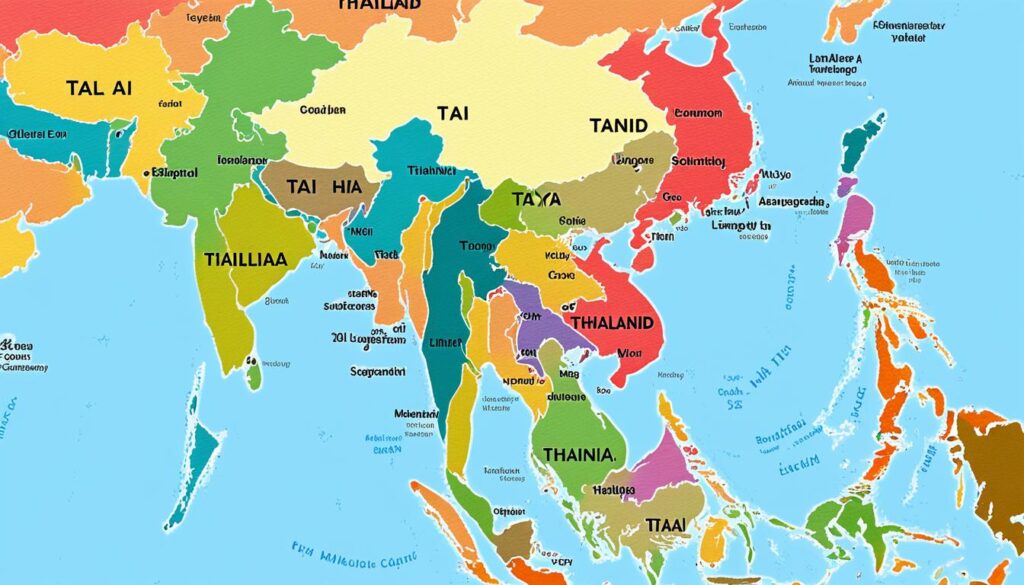Welcome to our fascinating exploration of the Tai Ya language, a hidden gem amongst the world’s indigenous languages. Did you know that the Tai Ya language, also known as Tai Cung or Tai Chung, is spoken by around 5,000-6,000 people in Chiang Rai Province, Thailand? This mountain indigenous language holds a rich cultural heritage and is part of the Atayalic branch of the Austronesian dialect family, which includes the Atayal language spoken by the Atayal tribe in Taiwan. Let’s delve deeper into the origins, description, vitality, and preservation efforts of the Tai Ya language, celebrating its uniqueness and importance in the world.
Origins of the Tai Ya Language
The Tai Ya language has its origins in the Southwestern region of China, specifically in the beautiful province of Yunnan. As a member of the Southwestern Tai branch of the Kra-Dai language family, Tai Ya belongs to a linguistic lineage that spans across Southeast Asia.
The Tai Ya people, who are native speakers of the language, have a strong presence in the Red River and Jinsha River watershed regions of south-central Yunnan. Historically, the Tai Ya people migrated from China to Chiang Rai Province in Thailand during the late 1920s and 1930s, establishing communities and bringing their language with them.
Over generations, the Tai Ya language has been passed down orally, without a traditional script. Nevertheless, recent endeavors have aimed to document and study the language, guaranteeing its preservation and continued existence.
“The Tai Ya people’s migration from China to Thailand in the early 20th century brought the rich cultural and linguistic heritage of the Tai Ya language to new lands. Immersed in the lush landscapes of Yunnan and now thriving in Thailand, the Tai Ya language has roots that stretch across borders.”
Description of the Tai Ya Language
Tai Ya is a tonal language with a complex phonological system. It is known for its various dialects, with the most predominant one being Tai Hongjin, also known as Red Tai. The Tai Hongjin dialect is spoken by the Tai Ya people in both Yunnan Province, China, and Chiang Rai Province, Thailand.
The Tai Ya language is characterized by its unique lexical and grammatical features, including its tonal distinctions, word order, and verb morphology. Its tonal system plays a crucial role in conveying meaning, with five distinct tones used in the pronunciation of syllables. The tonal distinctions enable the creation of different words with the same consonant-vowel structure.
Furthermore, Tai Ya exhibits a subject-verb-object (SVO) word order in declarative sentences, which is a common feature in many Tai languages. This word order contributes to the clarity and efficiency of communication in the language.
“Tai Ya is a tonal language with a complex phonological system. It has various dialects, with the most predominant one being Tai Hongjin, also known as Red Tai.”
Tai Ya has a unique grammatical characteristic called “verb serializing.” This feature allows multiple verbs to be combined in a single sentence, expressing complex actions or sequences of events. For example:
Tai Ya phrase: “Me ya dou”.
Analyzing the phrase:
Word Definition Me I Ya go Dou eat Translation: “I go eat.”
Interestingly, the Tai Ya language does not possess a traditional writing system. This absence of a written form poses challenges for its preservation and transmission. Although efforts have been made to develop an orthography for Tai Ya, including the use of the Latin alphabet, it is still primarily an oral language passed down through generations.
The image below depicts the geographic distribution of the Tai Ya language:

Tai Ya Language Vitality and Endangerment
The Tai Ya language, spoken by the Tai Ya people in Thailand, is currently facing endangerment. The lack of a writing system and its limited use in education and official domains have contributed to its decline. Many Tai Ya speakers in Thailand have shifted towards using Northern Thai and Central Thai, which are more widely used and have established written standards. This language shift poses a significant threat to the vitality of the Tai Ya language in Thailand.
However, despite the challenges, there is still hope for language revitalization and preservation. Linguists and local communities are taking proactive measures to document, teach, and promote the Tai Ya language. These efforts include the creation of written materials, the development of language programs, and raising awareness about the importance of preserving indigenous languages.
By creating an orthography for the Tai Ya language, linguists aim to enhance its recognition and use in education, literature, and other official domains. This would not only help in preserving the language but also foster a sense of pride and cultural identity among the Tai Ya people.
The revitalization of the Tai Ya language goes beyond linguistics; it is crucial for the preservation of the rich cultural heritage of the Tai Ya people. Language is an essential aspect of cultural expression, and the loss of a language can lead to the erosion of traditions, knowledge, and values. Therefore, preserving the Tai Ya language is vital to maintain the identity and heritage of the Tai Ya community.
Tai Ya Language in Thailand and China
The Tai Ya language is spoken by the Tai Ya people in both Thailand and China. In Thailand, there are approximately 1,000 Tai Ya speakers living in various villages and communities in Chiang Rai Province.
The largest concentration of Tai Ya speakers is in Ban Nam Bor Khaw, where the language is considered endangered. In China, the Tai Ya language is spoken by a larger population, estimated to be between 34,000 and 63,000 people.
Most Tai Ya speakers in China live in the Red River and Jinsha River watershed regions of Yunnan Province. The language has a stronger presence in China and is more widely spoken compared to its status in Thailand.

Tai Ya Population Comparison
| Location | Tai Ya Population |
|---|---|
| Thailand | Approximately 1,000 |
| China | Between 34,000 and 63,000 |
Efforts to Preserve the Tai Ya Language
Preserving and revitalizing the Tai Ya language is of utmost importance to ensure its survival and continued vitality. Various initiatives have been undertaken by linguists and community organizations to document, support literacy, and promote language revitalization among the Tai Ya community.
First, linguists have been actively documenting the Tai Ya language, recording oral traditions, narratives, and cultural practices. This documentation serves as a valuable resource for future generations to understand and appreciate the linguistic heritage of the Tai Ya people.
Additionally, written materials in Tai Ya are being created to support language learning and preservation efforts. These materials include textbooks, dictionaries, and other educational resources that facilitate the transmission of the language.
Efforts are also being made to establish Tai Ya literacy programs and develop language curricula. These initiatives aim to enhance the use and transmission of the language among the Tai Ya community, especially younger generations. By promoting education in Tai Ya, individuals can develop strong language skills and a deeper connection to their cultural identity.
Language revitalization initiatives play a crucial role in raising awareness among the Tai Ya community about the importance of their linguistic heritage. Through community engagement programs, workshops, and cultural events, efforts are made to encourage language use in daily life and foster a sense of pride in the Tai Ya language.
Here is a detailed table highlighting the main efforts and initiatives for preserving the Tai Ya language:
| Preservation Effort | Description |
|---|---|
| Language Documentation | Linguists record and document the Tai Ya language, including its vocabulary, grammar, and phonetics. |
| Tai Ya Literacy Programs | Establishment of literacy programs to promote reading and writing skills in Tai Ya. |
| Creation of Written Materials | Development of written materials, such as textbooks and dictionaries, to support language learning and preservation. |
| Language Curricula | Development of language curricula to enhance the use and transmission of Tai Ya in educational institutions. |
| Community Engagement | Organizing workshops, cultural events, and activities to raise awareness and foster pride in the Tai Ya language. |
The collective efforts to preserve the Tai Ya language are crucial in maintaining the rich cultural heritage and linguistic diversity of the Tai Ya people. By investing in these initiatives, we can ensure that future generations have the opportunity to learn, use, and cherish this unique and valuable language.
Importance of Preserving the Tai Ya Language
Preserving the Tai Ya language is of utmost importance as it serves as a vital link to the cultural identity and heritage of the Tai Ya people. Language is not merely a means of communication but also a reflection of the unique traditions, knowledge, and values that have been passed down through generations. Without the preservation of the Tai Ya language, these cultural elements may be lost, leading to a significant erosion of the Tai Ya people’s cultural identity.
In addition to preserving cultural heritage, the importance of maintaining the Tai Ya language extends to the broader context of linguistic diversity. Every language, including Tai Ya, offers distinct insights into human cognition and communication. By safeguarding indigenous languages like Tai Ya, we contribute to the preservation of valuable linguistic diversity, which is essential for understanding the complexity and richness of human expression.
Furthermore, preserving the Tai Ya language is a way to foster inclusivity and honor the rights and contributions of indigenous communities. By recognizing and promoting the use of indigenous languages, we create a more inclusive society that celebrates the diverse linguistic heritage of its people. It is essential to ensure that the Tai Ya language is given the respect and support it deserves, enabling the Tai Ya community to thrive and maintain their cultural and linguistic traditions for future generations.
Ultimately, the preservation of the Tai Ya language is an investment in the preservation of cultural identity, indigenous heritage, and linguistic diversity. By taking proactive measures to document, revitalize, and promote the use of the Tai Ya language, we can ensure that it continues to thrive as an invaluable piece of the Tai Ya people’s heritage and contributes to the mosaic of humanity’s linguistic tapestry.

Benefits of Preserving the Tai Ya Language
| Benefits | Description |
|---|---|
| Cultural Identity | The Tai Ya language is integral to preserving the cultural identity and heritage of the Tai Ya people. |
| Knowledge Preservation | Preserving the language ensures the survival of traditional knowledge, traditions, and values. |
| Linguistic Diversity | The preservation of Tai Ya contributes to the overall linguistic diversity of the world. |
| Inclusivity | Promoting the use of Tai Ya language respects the rights and contributions of indigenous communities, fostering inclusivity. |
| Human Expression | Tai Ya language offers unique insights into human cognition and communication, enriching our understanding of human expression. |
Conclusion
The Tai Ya language holds immense cultural and historical significance for the Tai Ya people in Thailand and China. While it faces the threat of endangerment, efforts are underway to preserve and revitalize this unique linguistic heritage. Language documentation projects, revitalization initiatives, and community-driven efforts play a vital role in ensuring the continued use and transmission of the Tai Ya language.
Preserving the Tai Ya language is not just about safeguarding a linguistic system; it is about preserving a cultural identity and heritage. Language serves as a gateway to a community’s traditions, knowledge, and values. By protecting the Tai Ya language, we also protect the diverse expressions of the Tai Ya people’s culture, enriching the global tapestry of human experience.
Furthermore, preserving indigenous languages like Tai Ya contributes to the overall linguistic diversity of the world. Each language offers unique insights into human cognitive and communicative abilities. By valuing and embracing linguistic diversity, we foster inclusivity and recognize the rights and contributions of indigenous communities.
It is imperative that we recognize the importance of preserving the Tai Ya language and take active steps to ensure its survival. By supporting language preservation efforts and raising awareness about the significance of indigenous languages, we can safeguard cultural heritage, encourage linguistic diversity, and promote a more inclusive and respectful world.
FAQ
What is the Tai Ya Language?
The Tai Ya Language, also known as Tai Cung or Tai Chung, is a Southwestern Tai language spoken by the Tai Ya people in southern China and Chiang Rai Province, Thailand. It belongs to the Kra-Dai language family and is a part of the Tai linguistic subgroup.
Where is the Tai Ya Language spoken?
The Tai Ya Language is spoken by the Tai Ya people in southern China, specifically in Yunnan Province, as well as in Chiang Rai Province, Thailand.
Does the Tai Ya Language have any dialects?
Yes, the Tai Ya Language has one dialect called Tai Hongjin, also known as Red Tai. It is predominantly spoken by the Tai Ya people in Yunnan Province, China, and Chiang Rai Province, Thailand.
Is there a traditional orthography for the Tai Ya Language?
No, the Tai Ya Language does not have a traditional writing system. It is primarily an oral language, although efforts have been made to develop an orthography for its preservation.
Is the Tai Ya Language endangered?
Yes, the Tai Ya Language is currently considered endangered, particularly in Thailand. The lack of a writing system and limited use in education and official domains have contributed to its decline.
How many Tai Ya speakers are there?
There are approximately 1,000 Tai Ya speakers in Thailand and an estimated population of between 34,000 and 63,000 Tai Ya speakers in China.
What efforts are being made to preserve the Tai Ya Language?
Various initiatives, including language documentation, literacy programs, and language revitalization projects, are being undertaken to preserve and revitalize the Tai Ya Language.
Why is it important to preserve the Tai Ya Language?
Preserving the Tai Ya Language is crucial for maintaining the cultural identity and heritage of the Tai Ya people, contributing to linguistic diversity, and fostering inclusivity and respect for indigenous communities.
